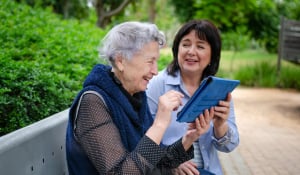Cognitive Stimulation: Brain Games, Reminiscing and Finding Success with Memory Impairment

When you hear the words cognitive stimulation what comes to mind? Brain games, crossword puzzles, word searches, trivia? These are all activities that provide cognitive stimulation, but they also require a level of skill and focus that someone living with Alzheimer’s or dementia may not have. In fact, participating in these types of activities may leave someone with Alzheimer’s or dementia feeling a lower level of self-esteem if they cannot complete the activity or answer any of the questions asked. We can all relate to the feeling of frustration when we can’t think of the answer in trivia or come up with the word in a crossword puzzle. It is during these times that an activity meant to increase cognitive stimulation ends up causing frustration and a decrease in self-confidence. The good news is cognitive stimulation can be achieved in many forms and finding the right fit for someone living with Alzheimer’s or dementia is something we will explore in this article!
In many aspects of caring for someone with Alzheimer’s or dementia you need be thinking outside the box. From finding ways to assist someone with getting dressed in the morning to making sure they are eating well-balanced and nutritious meals, you quickly become a creative caregiver. Finding ways to promote cognitive stimulation is no exception to your role as the creative caregiver.
Are activities like word searches, brain games and trivia leaving both you and the person you care for feeling frustrated and unaccomplished? Another activity you can try to promote cognitive stimulation is: reminiscing!
Reminiscing is proven to stimulate the brain while also allowing the individual with memory impairment to feel good about themselves. When most people think about reminiscing, they might think about looking through old photo albums or home movies- and this is great, but we can also add a bit more to truly make it a cognitively stimulating activity. One way to do this is theme reminiscing; it takes time and planning but is well worth the effort!
Here are some examples to consider as we enjoy Autumn in New England:
- Back to school: This does not mean you need to focus on memories of grammar school; be creative. Maybe bring back pictures or videos from high school, senior prom, graduation or even college! Think about meaningful moments that happened in your loved one’s life. When did they meet their husband/wife? When did they get married? Have their first kid? One example is, if the person living with Alzheimer’s or dementia met their significant other in college, bring that part of their life alive by retelling stories, bringing out the college yearbook or looking at the college mascot. With so much of our life happening virtually you may even be able to tour their old college online – or if you live close enough take a drive there to look around. Did they have a favorite food they ate in college? Enjoy a little baking project and cook your own version at home!
- First job: everyone needs to feel a purpose, this includes someone living with Alzheimer’s or dementia. Reminiscing about a first job will not only bring about feelings of nostalgia but also feelings of accomplishment, purpose and connection to the greater society.
- First apartment or home: a lot of people find themselves moving in Autumn – maybe into college or into/out of an apartment. Talk about the joys, struggles and funny stories from moving away from family for the first time or the joys and challenges of first-time home ownership.
There are so many creative opportunities to take a trip down memory lane and take reminiscing to the next level to promote cognitive stimulation. If you find a successful topic, keep the photos, videos and ideas saved to use again later. Involve family and friends by inviting others to send pictures, take new photos or connect over Zoom! Maybe ask a grandchild to zoom with their grandparent and compare their college experiences. There is no wrong way to practice cognitive stimulation, but we hope that this article will inspire you to start thinking of creative ways to practice it on your own!
This piece was written in collaboration with Laurelwood at the Pinehills Avita Program Director, Alison Stockman.
—
Discover life at a Northbridge community
If you’re considering senior living for yourself or a family member, we hope you’ll visit one of our communities. You’ll find a maintenance-free, activity-filled and engaging lifestyle to help support your wellness goals.
You’ll also discover many benefits in a Northbridge Senior Living community, including our Signature Program S.T.A.R. Club (Sharp Thinking, Active Residents) – which offers our residents several activities to participate in with others, including:
- Daily exercise group
- Walking club
- Tai Chi & Yoga
- Nutritional classes
- Library and book club
- Museum outings
- Artists in residence program
- Multi-generational music
- Genealogy Generations
We’re here to answer any of your questions and invite you to download our complimentary guide Just the Facts: Your Guide to Memory Care. Please contact us if we can provide further information or if you would like to schedule a personalized tour. 